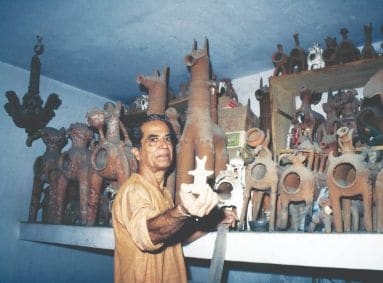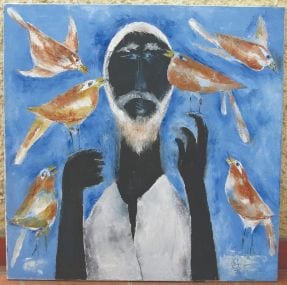This year’s Holi left the Indian art scene a little bereft of colour with the passing of renowned artist Haku Shah. Belonging to the Baroda School of Art, Hakubhai — as he was fondly called — was one of the many artists, who brought about the revival of Indian techniques and themes in contemporary art. From the 1950s through the 70s, many such schools and movements emerged to hark back to Indian techniques and themes, breaking away from decades of European influence before them. [caption id=“attachment_6367161” align=“alignleft” width=“383”]  Haku Shah[/caption] The Baroda School emerged after the setting up of the Faculty of Fine Arts at the Baroda College (now Maharaja Sayajirao University) in 1950. It became the springboard from where the careers of many great artists such as Bhupen Khakhar, Gulam Mohammed Sheikh, Ratan Parimoo, Rekha Rodwittiya, Jyoti Bhatt, Vivan Sundaram, and KG Subramanyan were launched. Padma Vibhushan KG Subramanyan once said of his student’s work, “The disarming simplicity of Haku Shah is deceptive.” Not so simple While an artist may appreciate the ‘deception’ of Shah’s concealed skill, it is the simplicity of his creations that is most appealing to the layperson — something not commonplace in contemporary art. Shah, who was awarded the Padma Shri in 1989, was known to be a figurative artist and many simplistic faces and forms peer out pleasantly from his body of work. In fact, the lone cowherd is ubiquitous in his art — a figure that fits as well in the African Savannas as in the Hindu mythic imagination. The bright colours and nature motifs lend universality to his oeuvre and make it easy to relate to. But, there is a lot more to the work he produced in a career spanning over six decades. Many sides of Shah Shah’s practised elegance was the result of many artistic and philosophical influences. Among other things, he was a staunch Gandhian, and lived by those principles all his life. A soft-spoken, khadi-wearing artist, he taught at the Gandhi ashram in Gujarat’s Vedchhi village, while also being a faculty member at the prestigious National Institute of Design, Ahmedabad, and a lecturer at several other international institutions. His sympathies lay, however, with rural India and, like Gandhi, he believed in empowering the sons living closest to the soil. A 2014 solo exhibition at Gandhi Ashram, Ahmedabad, showcased his abiding admiration for his icon and his message. The paintings of this collection have also been compiled in a book titled Nitya Gandhi: Living ReLiving Gandhi. [caption id=“attachment_6367171” align=“alignleft” width=“287”]  A work by Haku Shah[/caption] Folk art was another veritable influence in Shah’s art, and he worked consistently to bridge the gap between the craftsman and the artist. For Hakubhai, the two were seamless and he bristled at the difference between what is denoted as ‘high’ and ‘low’ art in common parlance. In his role as a scholar and cultural anthropologist, Shah continuously engaged with several folk art practices. For example, he was inspired by the art of the tribes of Rani Paraj, and the votive terracotta horses made at Poshina village in Gujarat. Shah’s lifelong passion for the folk arts was manifest in many of his collaborative endeavours, including those with noted Indic scholar and critic Stella Kramrisch in the exhibition ‘Ritual Art in Tribe and Village — Art of the Unknown’ at the Philadelphia Museum of Art, as early as 1968, and in his setting up of the tribal museum at Gujarat Vidyapith in the 1970s. Only last month, Tanishka Kachru and Neelima Hasija from NID, put together an exhibition, ‘Votive Terracotta of India: The Scholarly Work of Haku Shah’, to honour the artist’s extensive work in this sphere. At the time, the curators will not have known that Shah’s time here was limited, but cementing his most precious legacy thus has served as a sweet if inadvertent memoriam. (Urmi Chanda-Vaz is a psychologist by training, and dabbles in Indian history and culture)
Haku Shah’s creations combined the fine with the folk, scholarship with skill, and profundity with humility
Advertisement
End of Article


)

)
)
)
)
)
)
)
)



